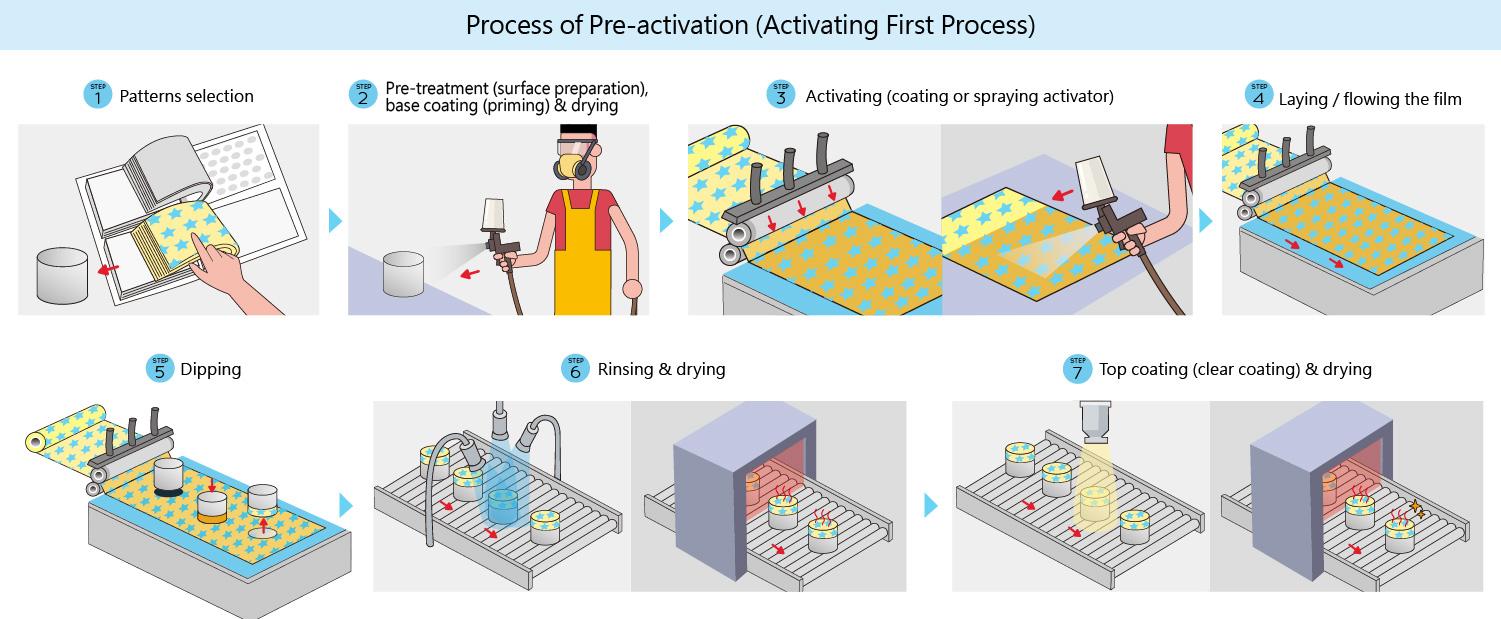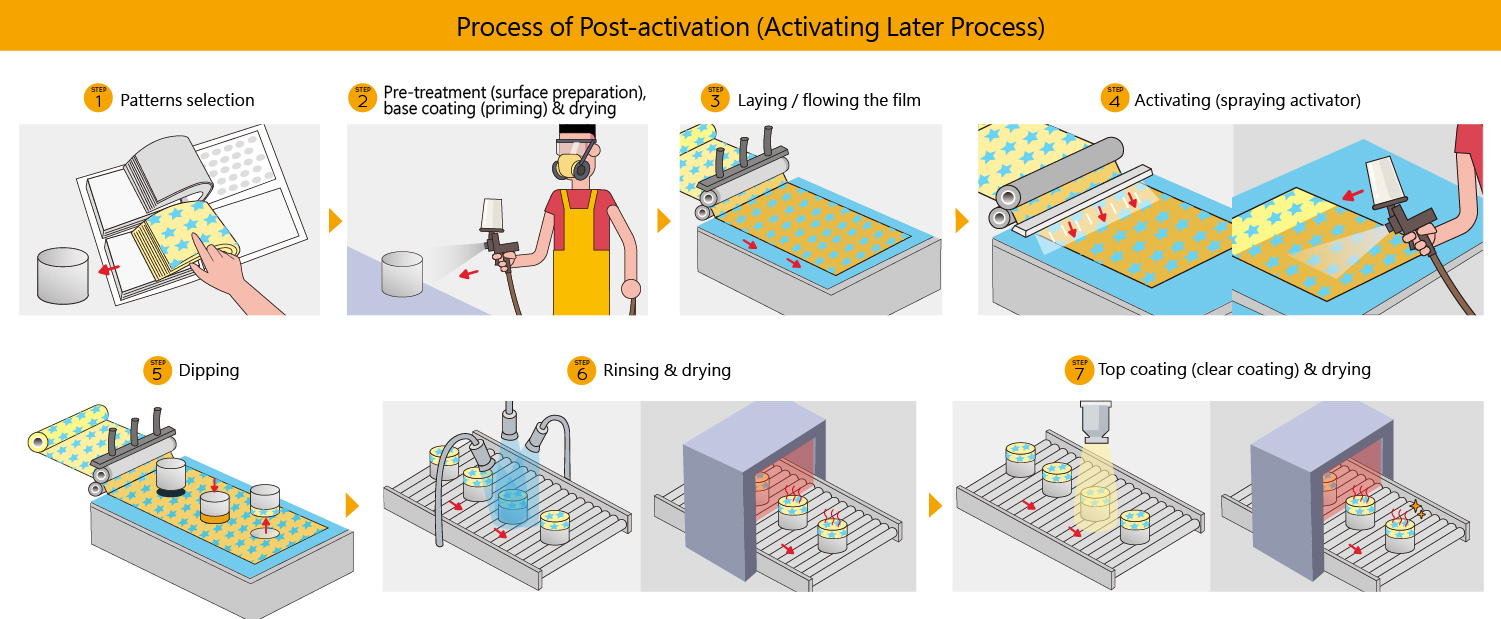You have 0 items in your cart.
Hydrographic Process
There are 2 types of water transfer printing processes: pre-activation (activating first) and post-activation (activating later). The main difference is the order of activating and film laying; besides, activator can be sprayed or coated in the pre-activation process but it is mainly sprayed in the post-activation process. IFFA's automatic dipping systems and manual dipping tanks are applicable in both of the processes. IFFA's hydrographic film works perfectly in both of the processes.
Process of Pre-activation (Activating First Process)
01Patterns selection
Customers can pick the common patterns from IFFA's website and IFFA's pattern album, or contact IFFA to develop custom patterns.
02 Pre-treatment (surface preparation), base coating (priming) & drying
Clean, defat, despumate, flame treat or remove rust on the substrate piece to keep its surface cleanness for base coat. Select the matched base coat according to the material and choose the proper color then spray it uniformly on the substrate piece. Dry the substrate piece after base coating. The process here is to ensure that there will be a good connection between base coat and IFFA's ink.
03Activating (coating or spraying activator)
Coat or spray the activator on IFFA's hydrographic film then the ink will be re-activated and become soft and flexible.
04Laying / flowing the film
(1) Manual dipping tank: lay the piece of IFFA's hydrographic film which has been sprayed activator on the water and make sure the printed side up and there is no bubbles between film and water.
(2) Automatic dipping system: lead the roll of IFFA's hydrographic film which has been coated activator on the water with the flowing speed and make sure the printed side up and there is no bubbles between film and water.
05Dipping
Wait 90 to 120 seconds (based on water temperature) until the film base almost dissolved. Then dip the jigged substrate piece into the water to be surrounded well by IFFA's ink. We recommend that the substrate piece stay in the water about 30 seconds for more stable adhesion.
06Rinsing & drying
Take out the printed substrate piece and put it in the washer to rinse off the remaining residual. Please notice the water pressure. If the water pressure is too high, it will possibly damage the printed layer. After rinsing, remove the waterdrops on the substrate piece by air knife dryer. Then air-dry it or dry it in the oven to shorten the waiting time. The proper baking temperature for plastic is about 50-60℃ and it should be higher for ceramic, glass and metal.
07Top coating (clear coating) & drying
Apply clear coat on the surface of substrate piece for anti-scratch, acid and alkali resistant or weather resistant purposes. The clear coat can be thinner base (dried by oven) or UV base (dried by UV light).
Process of Post-activation (Activating Later Process)
01Patterns selection
Customers can pick the common patterns from IFFA's website and IFFA's pattern album, or contact IFFA to develop custom patterns.
02Pre-treatment (surface preparation), base coating (priming) & drying
Clean, defat, despumate, flame treat or remove rust on the substrate piece to keep its surface cleanness for base coat. Select the matched base coat according to the material and choose the proper color then spray it uniformly on the substrate piece. Dry the substrate piece after base coating. The process here is to ensure that there will be a good connection between base coat and IFFA's ink.
03Laying / flowing the film
(1) Manual dipping tank: lay the piece of IFFA's hydrographic film on the water and make sure the printed side up and there is no bubbles between film and water.
(2) Automatic dipping system: lead the roll of IFFA's hydrographic film on the water with the flowing speed and make sure the printed side up and there is no bubbles between film and water.
04Activating (spraying activator)
Spray the activator on IFFA's hydrographic film then the ink will be re-activated and become soft and flexible. Spraying is the main method for post-activation (activating later) process.
05Dipping
Wait 90 to 120 seconds (based on water temperature) until the film base almost dissolved. Then dip the jigged substrate piece into the water to be surrounded well by IFFA's ink. We recommend that the substrate piece stay in the water about 30 seconds for more stable adhesion.
06Rinsing & drying
Take out the printed substrate piece and put it in the washer to rinse off the remaining residual. Please notice the water pressure. If the water pressure is too high, it will possibly damage the printed layer. After rinsing, remove the waterdrops on the substrate piece by air knife dryer. Then air-dry it or dry it in the oven to shorten the waiting time. The proper baking temperature for plastic is about 50-60℃ and it should be higher for ceramic, glass and metal.
07Top coating (clear coating) & drying
Apply clear coat on the surface of substrate piece for anti-scratch, acid and alkali resistant or weather resistant purposes. The clear coat can be thinner base (dried by oven) or UV base (dried by UV light).




